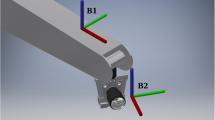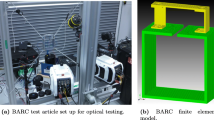Abstract
Recently, digital-image-correlation techniques have been used to accurately determine two-dimensional in-plane displacements and strains. An extension of the two-dimensional method to the acquisition of accurate, three-dimensional surfacedisplacement data from a stereo pair of CCD cameras is presented in this paper.
A pin-hole camera model is used to express the transformation relating three-dimensional world coordinates to two-dimensional computer-image coordinates by the use of camera extrinsic and intrinsic parameters. Accurate camera model parameters are obtained for each camera independently by (a) using several points which have three-dimensional world coordinates that are accurate within 0.001 mm and (b) using two-dimensional image-correlation methods that are accurate to within 0.05 pixels to obtain the computer-image coordinates of various object positions. A nonlinear, least-squares method is used to select the optimal camera parameters such that the deviations between the measured and estimated image positions are minimized.
Using multiple orientations of the cameras, the accuracy of the methodology is tested by performing translation tests. Using theoretical error estimates, error analyses are presented. To verify the methodology for actual tests both the displacement field for a cantilever beam and also the surface, three-dimensional displacement and strain fields for a 304L stainless-steel compact-tension specimen were experimentally obtained using stereo vision. Results indicate that the three-dimensional measurement methodology, when combined with two-dimensional digital correlation for subpixel accuracy, is a viable tool for the accurate measurement of surface displacements and strains.
Similar content being viewed by others
References
Riley, W.F. and Durelli, A.J., “Application of Moiré Methods to the Determination of Transient Stress and Strain Distributions,” J. Appl. Mech.,29 (1), (1962). 0416 0737 V 3
Oplinger, D.W., “Application of Moiré Methods to Evaluation of Structural Performance of Composite Materials,”Opt. Eng.,21 (4),626–632 (1982).
Ligtenberg, F.K., “The Moiré Method: A New Experimental method for the Determination of Moments in Small Slab Models,”Soc. for Exp. Stress Analysis,12 (2),83–98 (1955).
Kao, T.Y. andChiang, F.P., “Family of Grating Techniques of Slope and Curvature Measurements for Static and Dynamic Flexure of Plates,”Opt. Eng.,21 (4),721–742 (1982).
Pirodda L., “Shadow and Projection Moiré Techniques for Absolute or Relative Mapping of Surface Shapes,”Opt. Eng.,21 (4),640–649 (1982).
Haines, K.A. andHildebrand, B.P., “Surface-Deformation Measurement Using the Wavefront Reconstruction Technique,”Appl. Opt.,5 (4),595–602 (1966).
Gottenburg, W.G., “Some Applications of Holographic Interferometry,”Experimental Mechanics,8,281–285 (1969).
Post, D., Moiré Interferometry,” Handbook on Experimental Mechanics, ed. A.S. Kobayashi, Chapt. 8, Prentice-Hall (1987).
Hung, Y.Y. andTaylor, C.E., “Measurement of Slopes of Structural Deflections by Speckle Shearing Interferometry”,Experimental Mechanics,14 (7),281–285 (1974).
Archbold, E., Burch, J.M. andEnnos, A.E., “Recording of in-Plane Surface Displacements by Double Exposure Speckle Photography”,J. for Physics in Eng.: Scientific Instruments,4,277–279 (1971).
Stetson, K.A., “A Review of Speckle Photography and Interferometry,”Opt. Eng.,14, (5),482–489 (1975).
Parks, V.J., “The Range of Speckle Metrology”,Experimental Mechanics,20 (6),181–191 (1980).
Peters, W.H., Ranson, W.F., “Digital Image Techniques in Experimental Stress Analysis,”Opt. Eng.,21, (3),427–431 (1982).
Sutton, M.A., Wolters, W.J., Peters, W.H., Ranson, W.F. andMcNeill, S.R., “Determination of Displacements Using an Improved Digital Correlation Method”,Image and Vision Computing,1, (3),133–139 (1983).
Chu, T.C., Ranson, W.F., Sutton, M.A., Peters, W.H., “Applications of Digital image Correlation Techniques to Experimental Mechanics,”Experimental Mechanics,25 (3),232–244 (1985).
Sutton, M.A., Cheng, M.Q., Peters, W.H., Chao, Y.J. andMcNeill, S.R., “Application of an Optimized Digital Correlation Method to Planar Deformation Analysis,”Image and Vision Computing,4, (3),143–151 (1986).
Sutton, M.A., McNeill, S.R., Jang, J. andBabai, M.K., “Effects of Subpixel Image Restoration on Digital Correlation Error Estimates,”Opt. Eng.,27 (10),870–877 (1988).
He, Y., Tan, Wan, Y., Ku C. and Smith, E.W., “3-D Displacement of the Crack Tip Measured by Microimage Plane Holography and Specklegraphy Separating Technique”, Proc. 1989 SEM Spring Conf. on Exp. Mech., 301–305 (1989).
Peters, W.H., Sutton, M.A., Poplin, W.P. andWalker, D.M., “Whole Field Experimental Displacement Analysis of Composite Cylinders,”Experimental Mechanics,29 (1),58–63 (1989).
Sobel, I.E., “Camera Models and Machine Perception,” Stanford Artificial Intelligence Project, PhD Thesis, Stanford Univ. (1970).
Sobel, I.E., “On Calibrating Computer Controlled Cameras for Perceiving 3D Scenes,”Artificial Intelligence,5,185–198 (1974).
Parrish, E.A. andGoksel, A.K., “A Camera Model for Natural Scene Selection,”9,131–136 (1977).
Kahn-Jetter, Z.L. andChu, T.C., “Three-dimensional Displacement Measurements Using Digital Image Correlation and Photogrammic Analysis,”Experimental Mechanics,30 (1)10–16 (1990).
Yakimovsky, Y., “A System for Extracting 3D Measurements from a Stereo Pair of TV Cameras,”Computer Graphics 7,195–210 (1978).
Barnard, S.T. andFischler, M.A., “Computational Stereo,”Computing Surveys,14 (4),553–572 (1982).
Tsai, R.Y., “A Versatile Camera Calibration Technique for High Accuracy 3D Machine Vision Metrology Using Off-the-Shelf TV Cameras and Lenses,”IEEE J. of Robotics and Automation,RA-3 (4),323–344 (1987).
Tsai, R.Y., “Accuracy Analysis and Prediction for 3D Robotics Vision Metrology,” IBM Research Rep. RC 11348.
IMSL Subroutine ZXSSQ, Problem Solving Software System for Mathematical and Statistical FORTRAN Programming, Edition 9.2 (1984).
Lenz, R.K. andTsai, R.Y., “Calibrating a Cartesian Robot with Eye-on-Hand Configuration Independent of Eye-to-Hand Relationship”,IEEE Trans. on Pattern Analysis and Machine Intelligence,11, (9),916–928 (1989).
Timoshenko, S.P. and Goodier, J.N., Theory of Elasticity, McGraw-Hill Book Company, Third Ed. (1970).
Luo, P.F., Chao, Y.J., Sutton, M.A., and Peters, W.H., “Optimal Arranbgements of the Stereo Imaging System for the Measurement of Three-Dimensional Displacement,”, Proc. of the XV Southeastern Conf. on Theoretical and Applied Mechanics, 789–795 (1990).
ASTM Metals Test Methods and Analytical Procedures, 03 01 (1990).
Sutton, M.A., Turner, J.L., Bruck, H.A., andChae, T.L., “Experimental Investigations of Three-Dimensional Effects Near a Crack Tip Using Computer Vision”,Int. J. of Fracture Mechanics,53,201–228 (1992).
Chae, T., Bruck, H.A., Sutton, M.A. andTurner, J.L., “Full-field Representation of Discretely Sampled Surface Deformation for Displacement and Strain Analysis,”Experimental Mechanics,31, (2),168–177 (1991).
Author information
Authors and Affiliations
Rights and permissions
About this article
Cite this article
Luo, P.F., Chao, Y.J., Sutton, M.A. et al. Accurate measurement of three-dimensional deformations in deformable and rigid bodies using computer vision. Experimental Mechanics 33, 123–132 (1993). https://doi.org/10.1007/BF02322488
Received:
Revised:
Issue Date:
DOI: https://doi.org/10.1007/BF02322488




